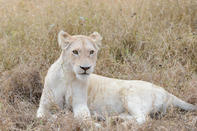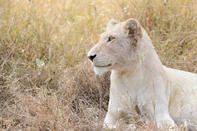An Extreme Rarity
White lions are not albinos, but rather leucistic. In other words, they get their pale colouration from a recessive gene that shows up from time to time in the lion populations of the greater Kruger National Park.

For a white lion to be born, both parents must carry the gene. However, the cubs seldom survive into adulthood, as they stand out like white rabbits in the veld, and are difficult to hide from predators. They are also thought to be at a disadvantage in the hunting department. Thus, adult white lions are an extreme rarity.
The Timbavati Reserve and western Kruger Park remain the only true homes of these magnificent cats, and, as some of the prides there carry the white genetic code, a new white lion can be born at any time. These cats were first studied back in the 1970s by a young zoologist, Chris McBride.
His famous book, The White Lions of the Timbavati, put the reserve and its lions on the map. Other reports started filtering in of white lions in the Tshokwane area of the Kruger Park, but the highest recorded prevalence of the gene is found among the Timbavati lions.
Did you know?

The two cubs discovered by zoologist Chris McBride in 1975 were the first in a line of white lions that have been recorded and studied in the area. Their fame spread far and wide. In the early 1980s, McBride campaigned to have the white lions removed from the Timbavati to protect their future.
This led to a situation where white lions became far more common in breeding centres, zoos, theme parks and in the nefarious canned-hunting trade than in the wild. Today, there are probably more than three hundred white lions worldwide. They can fetch up to R2 million each, which has led to many unethical business practices.
By Justin Fox White rhino are the second largest land mammals on earth and as such enjoy a position amongst the ‘Big 5’ – historically those animals...
White rhino are the second largest land mammals on earth and as such enjoy a position amongst the ‘Big 5’ – historically those animals... Timbavati Game Reserve covers approximately 53,000 hectares of unspoiled South African nature. It is located on the western edge of the Krug...
Timbavati Game Reserve covers approximately 53,000 hectares of unspoiled South African nature. It is located on the western edge of the Krug...